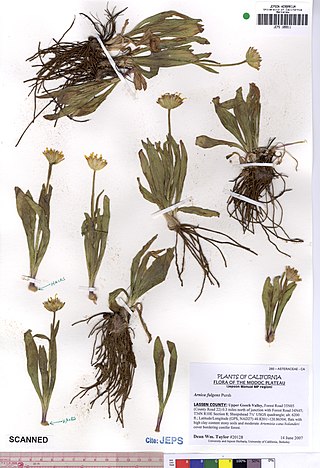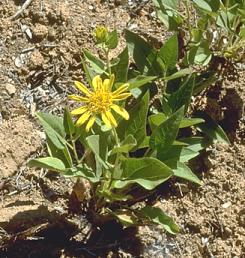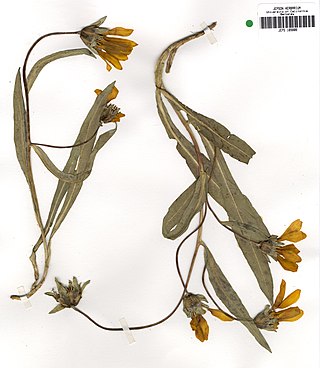Isocoma arguta is a rare species of flowering plant in the family Asteraceae known by the common name Carquinez goldenbush. It has been found only in Solano and Contra Costa Counties in California, where it grows in the Sacramento-San Joaquin River Delta. It is a resident of Suisun Marsh. It thrives on alkali flats and other mineral-rich soils.

Arnica fulgens is a species of arnica known by the common names foothill arnica and hillside arnica. It is native to western North America, from British Columbia east to Saskatchewan and south as far as Inyo County, California, and McKinley County, New Mexico. It grows in open, grassy areas.

Arnica venosa is a rare California species of flowering plant in the family Asteraceae known by the common name Shasta County arnica. It should not be confused with the Mt. Shasta arnica, A. viscosa.

Almutaster is a North American genus of plants in the family Asteraceae containing the single species Almutaster pauciflorus, which is known by the common name alkali marsh aster. It is native to Canada, the Western United States, and northern and central Mexico. The genus is named for botanist Almut Gitter Jones.

Balsamorhiza deltoidea is a species of flowering plant in the sunflower tribe of the plant family Asteraceae known by the common name deltoid balsamroot. It is native to western North America from British Columbia to California, where it grows in many types of generally mountainous habitat.
Balsamorhiza macrolepis is a species of flowering plant in the tribe Heliantheae of the family Asteraceae, known by the common name California balsamroot. It is found only in California, where it grows in dry, open habitat, mostly in mountainous areas, mostly in the western foothills of the Sierra Nevada and in the eastern Coast Ranges near San Francisco Bay. It is now becoming rare in the Coast Ranges.

Brickellia grandiflora, known by the common name tasselflower brickellbush, is a species of flowering plant in the family Asteraceae.
Calycadenia mollis is a species of flowering plant in the family Asteraceae known by the common name soft western rosinweed. It is native to a section of central California, from Tuolumne County do northern Tulare County. There are also isolated populations farther north in Nevada County. The plant grows in a number of habitat types in the Central Valley and adjacent Sierra Nevada foothills.
Calycadenia oppositifolia is a species of flowering plant in the family Asteraceae known by the common name Butte County western rosinweed. It is native primarily to Butte County, California, although a few populations have been found in other parts of the state. It grows in the foothills of the high mountain ranges.
Calycadenia spicata is a species of flowering plant in the family Asteraceae known by the common name spiked western rosinweed. It is endemic to central California, where is a common grassland plant in the Central Valley and adjacent Sierra Nevada foothills from Butte County to Kern County.
Erigeron multiceps is a species of flowering plant in the family Asteraceae known by the common names Kern River daisy and Kern River fleabane. It is endemic to California, where it is known mostly from the Kern Plateau in the southern High Sierra Nevada of eastern Tulare County. It is a perennial herb growing a hairy stem up to about 20 centimeters tall from a taproot and caudex. The base of the stem is surrounded by oblong leaves 2 to 5 centimeters long, and there are some smaller leaves along the length of the stem. The inflorescence produces hairy, glandular flower heads filled with yellow disc florets and a fringe of up to 125 thin, flat white to purple-tinged ray florets. The fruit is an achene with a pappus of bristles.

Chaenactis suffrutescens is a species of flowering plant in the aster family known by the common name Shasta chaenactis.

Arnica dealbata is a species of Californian plants in the tarweed tribe within the aster family

Agnorhiza bolanderi is a species of flowering plant known by the common name Bolander's mule's ears. It is endemic to California, where it is known only from a narrow section of the Sierra Nevada foothills about 275 kilometers long from Shasta County to Mariposa County. It grows in chaparral and grassland habitat, usually on serpentine soils.

Agnorhiza reticulata, known by the common name El Dorado County mule's ears, is a rare species of flowering plant found only in a small region of north-central California.

Agnorhiza elata is a species of flowering plants known by the common name Hall's mule's ears. It is endemic to California, where it is known only from a section of the central Sierra Nevada foothills. It occurs primarily in a region stretching from Tuolumne County to Fresno County, but a few isolated populations have been found in Tulare County.

Wyethia glabra is a species of flowering plant in the family Asteraceae known by the common name Coast Range mule's ears. It is endemic to California, where it grows in the North and Central Coast Ranges. It is a perennial herb growing from a tough taproot and caudex unit and producing a stem up to 40 centimeters tall. It is hairless to hairy and glandular. The leaves have lance-shaped or oval blades up to 45 centimeters long. The inflorescence is usually a solitary flower head or occasionally a cluster of 2 or more. The head has lance-shaped leaflike phyllaries at the base. It contains up to 21 yellow ray florets each up to 5 centimeters long and many yellow disc florets. The fruit is an achene over a centimeter long, including its pappus.
Agnorhiza invenusta is a species of flowering plant known by the common names Coville's mule's ears and rayless mule's ears. It is found only in California, where it grows in the Sierra Nevada foothills as in Fresno, Tulare, and Kern Counties.

Wyethia longicaulis is a species of flowering plant in the family Asteraceae known by the common name Humboldt mule's ears. It is endemic to California, where it occurs in the North Coast Ranges and the Klamath Mountains. It grows in mountain and foothill habitat such as grassland and forests. It is a perennial herb growing from a tough taproot and caudex unit and producing a stem up to half a meter tall. It is hairless to hairy and glandular. The leaves have lance-shaped or oblong blades up to 20 centimeters long. They are glandular and have a waxy exudate that dries white. The inflorescence is usually a cluster of 2 to 4 flower heads, each with up to 10 yellow ray florets which may be up to 3 centimeters long. The fruit is an achene about a centimeter long, including its tiny pappus.

Deinandra mohavensis, commonly known as Mojave tarplant or Mojave tarweed, is a species of flowering plant in the family Asteraceae.














